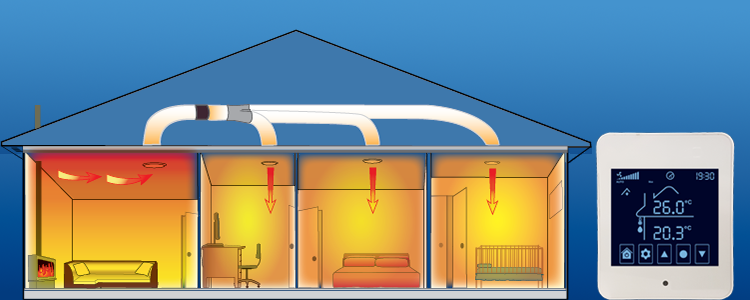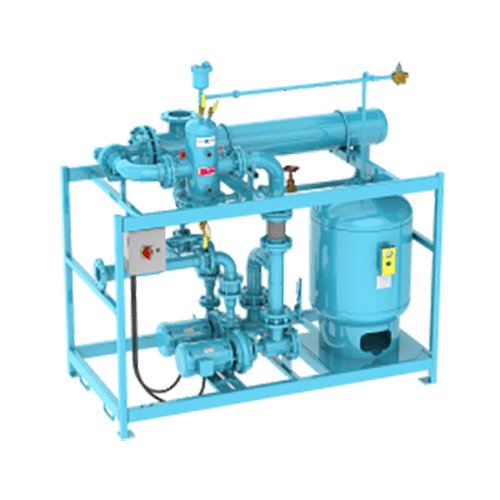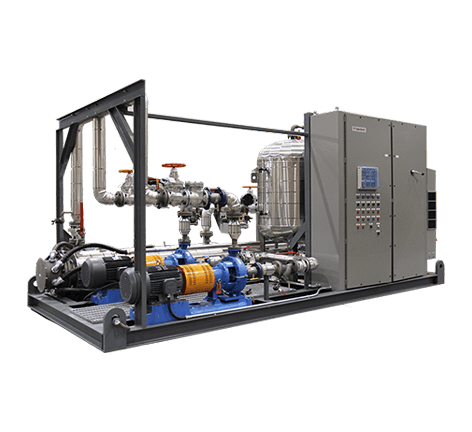The Duty of Heat Transfer Solutions in Sustainable Power Solutions for the Future
Heat transfer systems are crucial in the mission for sustainable energy solutions. They enhance thermal energy management, boosting the effectiveness of sustainable modern technologies. By employing mechanisms like radiation, transmission, and convection, these systems reduce energy losses. Their duty in solar thermal and geothermal applications is especially considerable. As advancements emerge, the possibility for additional developments increases essential questions concerning future energy approaches. What advancements will form the landscape of lasting power?
Recognizing Heat Transfer Systems

The Significance of Thermal Power Management
Efficient thermal power management is necessary for maximizing power performance and reducing waste in numerous systems. By controling temperature level and maximizing Heat transfer processes, organizations can substantially reduce power intake and operational costs. Efficient management involves the application of innovative technologies and practices that keep an eye on and regulate thermal problems within systems, ensuring that energy sources are used successfully. Furthermore, proper thermal energy administration adds to reducing greenhouse gas discharges, aligning with international sustainability objectives. It additionally boosts system integrity and efficiency, bring about improved product quality and longer equipment lifespan. Eventually, focusing on thermal energy administration is a crucial action in the direction of developing more lasting power solutions and promoting a responsible method to energy consumption in residential and industrial contexts.
Applications of Heat Transfer in Renewable Power
While numerous renewable resource resources guarantee sustainability, the reliable application of Heat transfer plays a crucial function in their performance. In wind power systems, Heat transfer is utilized for generator part cooling, improving performance and longevity. Geothermal energy depends on efficient Heat exchange in between the earth's subsurface and the fluid flowing in the system, optimizing power removal. Biomass power procedures likewise profit from Heat transfer, as it aids in converting organic materials right into useful gas with pyrolysis and gasification. Furthermore, in hydropower, maintaining excellent temperatures in storage tanks can improve energy outcome. Each of these applications demonstrates the critical significance of Heat transfer systems in enhancing sustainable power innovations, eventually adding to an extra lasting energy future.
Enhancing Solar Thermal Power Efficiency
As solar thermal power systems proceed to advance, improving their performance has actually become crucial for making the most of power outcome. Advancements in Heat transfer innovations, such as boosted thermal storage materials and cutting-edge Heat exchangers, play a substantial function in boosting performance. By making use of advanced products that have exceptional thermal conductivity, systems can move and record Heat more successfully. Additionally, integrating radar that comply with the sun's course assurances that enthusiasts get optimal solar exposure throughout the day. Utilizing nanotechnology in solar absorbers can further increase energy absorption prices. Moreover, including automatic control systems aids regulate temperature levels and manage power distribution successfully, resulting in reduced losses and enhanced overall system effectiveness. These improvements lead the method for even more sustainable solar thermal power solutions in the future.
Geothermal Heating: A Lasting Service
Geothermal heating presents a practical option for sustainable power, using substantial ecological benefits with decreased greenhouse gas emissions. Its effectiveness and cost-effectiveness make it an appealing alternative to conventional heater. Nonetheless, obstacles associated to application must be addressed to optimize its potential influence.
Environmental Benefits of Geothermal
Typical heating approaches add significantly to greenhouse gas exhausts, geothermal heating provides an engaging choice that decreases ecological influence. By using the Planet's inner Heat, geothermal systems utilize an eco-friendly power source, significantly lowering reliance on fossil fuels. This technique creates minimal carbon exhausts, making it a cleaner choice for industrial and property heating. In addition, geothermal systems advertise energy efficiency, as they call for much less power compared to conventional heater. DVS Heat Transfer Systems. The use of geothermal power also assists in lowering air contamination, boosting neighborhood air quality and public health. As a sustainable option, geothermal home heating sustains climate change reduction initiatives, positioning itself as an essential component in the shift in the direction of a greener future
Performance and Cost-Effectiveness
Just how does geothermal home heating measure up in regards to effectiveness and cost-effectiveness compared to conventional heating unit? Geothermal heating shows remarkable performance, typically accomplishing a coefficient of performance (POLICE) of 3 to 5, meaning it produces three to 5 devices of Heat for every device of electrical energy taken in. This effectiveness translates right into reduced operating expense, particularly in regions with secure geothermal sources. First installment expenses can be higher than conventional systems; however, lasting savings on power expenses and Continue reduced upkeep costs can offset these ahead of time investments. Additionally, several federal governments incentivize geothermal systems with discounts and tax obligation credit histories, enhancing their cost-effectiveness. On the whole, geothermal heating arises as a lasting and economically sensible option to more traditional heating solutions.
Execution Challenges and Solutions
Various obstacles can impede the extensive implementation of geothermal heating unit, regardless of their clear advantages as a sustainable power service. High first installation expenses often prevent investors and homeowners, making financing a considerable obstacle. Furthermore, the geographical limitations of appropriate geothermal websites limit accessibility in specific areas. Local regulations and permitting procedures can also complicate job development, causing hold-ups. Public understanding and understanding of geothermal systems stay reduced, hindering acceptance. To deal with these difficulties, targeted education and learning projects can boost open secret, while federal government motivations can minimize monetary burdens. Teaming up with local authorities to improve policies may help with smoother job approvals, ultimately promoting the adoption of geothermal heating as a practical, sustainable energy option.
Technologies in Heat Transfer Technologies
Technologies in Heat transfer innovations play a crucial function in enhancing energy efficiency and sustainability. Advanced Heat exchangers and phase change products are at the forefront of these advancements, offering considerable improvements in thermal management. These technologies not just maximize power usage however additionally add to lowering environmental influence in numerous applications.
Advanced Heat Exchangers
Advanced Heat exchangers play an essential duty in improving energy efficiency throughout different applications in lasting power options. These devices facilitate the transfer of Heat in between two or more fluids, substantially lowering power intake in processes such as industrial home heating, air conditioning, and power generation. Developments in materials and layout, such as making use of nanofluids and small setups, have actually brought about improved thermal efficiency and decreased dimension demands. Additionally, innovations in digital tracking and control systems enable enhanced procedure, further boosting efficiency. By lessening waste Heat and taking full advantage of power recovery, advanced Heat exchangers add to lower carbon footprints and sustain the change toward environmentally pleasant innovations. Their proceeded growth is important for accomplishing international power sustainability goals.
Stage Adjustment Materials
The combination of stage change materials (PCMs) into Heat transfer technologies represents a considerable development in energy administration and efficiency. PCMs soak up and launch thermal power during their phase adjustments, allowing effective temperature policy in building products and power systems. By saving excess Heat throughout optimal durations and releasing it when need increases, PCMs add to pack moving and energy conservation - DVS Heat Transfer Systems. This capability improves the performance of renewable resource systems, specifically in solar thermal applications. Furthermore, PCMs can enhance the thermal comfort of indoor settings, reducing dependence on standard home heating and cooling down techniques. As developments in PCM find this formulas proceed to emerge, their function in lasting energy services is positioned to expand, offering encouraging opportunities for future research study and application

Future Prospects for Heat Transfer in Sustainable Power
As the demand for sustainable energy remedies remains to climb, the duty of Heat transfer systems is coming to be increasingly critical fit future technologies. Developments in materials and styles are expected to improve performance in Heat transfer, minimizing energy losses in different applications. The assimilation of sophisticated thermal storage systems, such as phase adjustment materials and thermochemical storage space, will certainly allow much better administration of power sources. Research into nanofluids and biomimetic Heat exchangers might better optimize thermal efficiency. Furthermore, the adoption of wise modern technologies will enable real-time surveillance and adaptive control of Heat transfer processes. These developments are poised to greatly contribute to the total performance and sustainability of energy systems, leading the way for a much more energy-efficient future.
Often Asked Concerns
Exactly How Can Individuals Implement Heat Transfer Equipment in the house?

People can carry out Heat transfer systems in your home by mounting energy-efficient home appliances, using radiant home heating, and maximizing insulation. These procedures enhance energy efficiency, minimize costs, and promote sustainable techniques in domestic atmospheres.

What Are the Costs Associated With Installing Heat Transfer Systems?
The costs connected with installing Heat transfer systems vary widely, normally encompassing equipment, installation labor, and maintenance. Factors such as system kind, home size, and regional guidelines considerably affect the total expenditure involved.
Are There Federal Government Motivations for Heat Transfer System Installations?
Government motivations for Heat transfer system installations differ by region and can include tax obligation gives, credit histories, and rebates. These economic benefits aim to motivate adoption, inevitably promoting energy performance and minimizing environmental effect within areas.
Exactly How Do Heat Transfer Solutions Influence Power Expenses?
Heat transfer systems significantly influence energy costs by optimizing energy effectiveness. By enhancing the transfer of Heat, these systems decrease energy intake, resulting in reduced utility prices and creating an extra sustainable technique to energy management.
What Upkeep Is Needed for Heat Transfer Solutions?
Upkeep for Heat transfer systems includes normal evaluations, cleansing of components, inspecting fluid degrees, guaranteeing correct insulation, and changing worn parts. These jobs aid preserve performance, avoid malfunctions, and prolong the system's operational life expectancy.
These systems promote the movement of thermal energy from one medium to one more, enabling the transfer of Heat for energy, air conditioning, or heating generation functions. Geothermal power relies on efficient Heat exchange in between the planet's subsurface and the liquid circulating in the system, taking full advantage of power removal. In addition, geothermal systems advertise power performance, as they call for much less power contrasted to standard home heating systems. Advanced Heat exchangers play an important function in boosting power efficiency across various applications try this web-site in lasting energy solutions. Heat transfer systems especially affect power bills by optimizing energy efficiency.